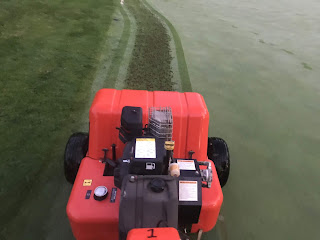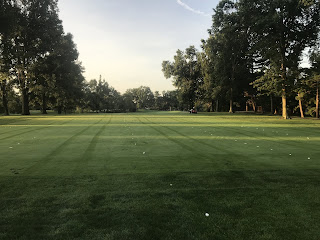Well, it's that "tine" of year again. Time for core (or hollow tine) aeration. We completed the greens aerification on September 3rd. Hollow tine plugs were pulled out, then removed, and the greens were given a heavy topdressing to fill in the aeration holes. Next up will be tees, followed by short rough, and finally, on October 8th, the fairways will get core aerated. (
click here for more information on aeration) Also, September and October are important times to fertilize cool season turfgrass. We will be fertilizing tees, fairways, and rough with a heavy nitrogen granular fertilizer once mother nature decides to put an end to the summer temperatures. The greens will get a lighter amount of organic macro-nutrients in the next couple of weeks. This fertilization will help the turf recover from summer stress and increase growth leading to a healthier stand of turfgrass.
 |
| Core aerating #5 green |
 |
| Topdressing the putting green after aeration |
It is also the time of year that the WHCC tree roots are having a big impact on turf health. After starting the year off very wet, the last couple of months have been extremely dry. That means that both the grass and trees are competing for available moisture. The areas where the trees are winning the battle are becoming noticeable, with big patches of brown and stressed out turf. We have been increasing our irrigation around these areas, but we need a good rain to saturate the soil enough to provide both plants with adequate moisture. September is the driest month for the Cincinnati area; however we need some rain and cooler temperatures for the turfgrass to fully recover.
 |
Tree roots out competing turf for moisture
|
 |
| The bentgrass on #12 approach and a pin oak tree struggling for available moisture |
Speaking of trees, there has been some tree maintenance occurring during the last couple of months. A few wind storms blew through and took down certain branches and entire trees. Also, several varieties put on heavy fruit, such as ginkos and oaks, that cause the branches to sag down, and sometimes break off.
 |
| Cleveland select pear losing a large branch |
 |
| Emerald ash borer causing the death of this ash tree, then toppling over during a wind storm |
Irrigation leaks seem to be picking up steam. We have had a multitude of pipe leaks in the last month. The wet spring made them hard to identify, but with the recent dry spell they have become easy to spot. Luckily, we have a dedicated irrigation crew, lead by Michael Westendorf, that has been keeping up with the pipe leaks, and leaky irrigation heads.
 |
| Bell-end pipe leak |
 |
| Chris Wheeler showing us the exact location of this leak. Thanks Wheels👍 |
We are, hopefully, on our last couple of spray applications for the year. It has been a long season of battling insects, funguses, and fertility issues but the end is in sight. Once the cool autumn temperatures arrive, the major diseases will no longer be an issue and the grass will not be consistently stressed allowing it to fight off many of the late season disorders. Come on fall!
 |
| A fairway spray application |
On the horticulture side, the annuals are hitting their stride. The new guinea impatiens are at their peak, and the tropical plants are certainly loving the extended hot summer weather. Some of the newer varieties that were planted this year like, the Mexican petunias,and the cleome, performed very well. In the next couple of weeks the fall annuals will be replacing some of the worn out summer annuals. So be on the lookout for mums, pansies, millet, and peppers to be making their appearance around the grounds. Also, this is the time of year we design the annual display (both spring and summer) for next season. We have some new and fresh ideas so stay tuned!
 |
| New guienea impatiens, redhead coleus, and euphorbia 'diamond frost' |
 |
| Mexican petunias, pink cleome, and pink pentas |
What do you get when you cross Bermuda grass with bluegrass?
Bluemuda (click here for more information) - and it could be the answer to our dormant, brown Bermuda grass fairway areas. This is a newer concept that has become increasingly popular in the transition zone over the last couple of years. It involves inter-seeding with newer varieties of Kentucky bluegrass into an already existing stand of Bermuda grass. The Kentucky bluegrass would thrive in the shoulder seasons and the Bermuda would take over during the summer. Both grasses have a creeping habit which would increase survival for this two grass system. We over-seeded a small area of Bermuda with an athletic field mix of Kentucky blue on #11 fairway. Bluegrass takes 20 days to germinate so we should see in October the success of this test plot. Another benefit of bluemuda is once the bluegrass is established, future over seeding would not be necessary. The more traditional option, in the transition zone, is to over seed with perennial rye. The rye-grass has quick germination and looks great in the fall and spring. However, the rye-grass is a bunch type grass that struggles in the heat and gets crowded out by the aggressive Bermuda, causing the over seeding process to take place again the following year. Bluemuda was recommended by the USGA agronomist, during his visit in May, and we will closely monitor the results.
 |
| Over-seeded area in #11 farway |
Brad Piecuch
Assistant Superintendent/Horticulturist











